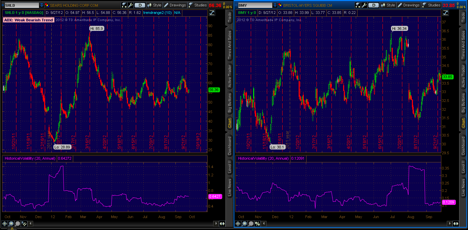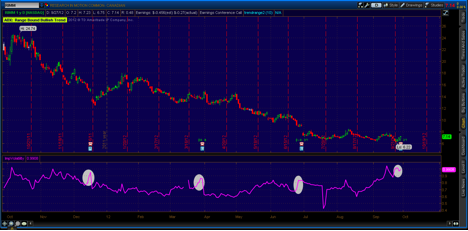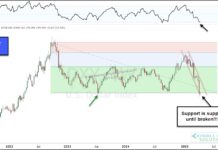Earnings season is right around the corner. And while I plan on posting an article specifically about trading options and/or stock into binary events such as earnings reports, today’s post will focus on defining some of the basic components that affect options pricing. Brad Tompkins has written a few informative posts on Options Basics, so be sure to review his posts as well.
Consider this to be part 1 of trading options into binary events.
So, without further delay, let’s dig into some key terminology and add some color for understanding.
Long – When you own the actual position or security. Similar to owning 100 shares of GE stock, if you are long GE calls, you own the calls.
Short – This concept is hard to comprehend for most newcomers to the market. To put it simply, it’s basically selling an option without actually owning it.
For stock traders this is simple enough. However, there’s a little confusion that may come into play when it comes to applying this to options. Recall that when you are long a name, you are bullish and when you are short, you are bearish. Also, being long a Call option is a bullish bet and being long a Put option is a bearish bet. So what is your thesis on the movement of the security if you end up opening a short Call? How about a short Put?
Basically, when you are opening a position to short a Call option, it’s a bearish bet. Why? It’s because you are shorting (selling) the security( the call option) that is bought by those who think the underlying is going higher. It’s the reverse on shorting a Put option.
Strike Price – Aka the exercise price, this refers to the agreed upon share price where the stock may be bought or sold.
Exercise – When the owner( the buyer of the long call or put) of an option invokes the right provided by for them under the terms of the option contract. Only the owners of the option contract can exercise. If the option owner decides to exercise the contract, the option seller is required to take the other side of the trade.
American vs. European Style – I will not dive too deep into this, as this is more trivial for the purpose of learning about equity options. Equity options are traded American style whereas European style is utilized by Index options. Both are practically the same in the sense of concept (strike price and presence of expiration date). However, one major difference that does affect the pricing of the option is that American style options give the option buyer/owner the ability to exercise the option contract at any time whereas European style options can only be exercised at expiration. For more info on option styles, try this auto search.
Assignment – Basically the other end of exercising the option contract. When the buyer exercises the option contract, the “seller” of the contract takes assignment of the underlying.
Volatility – A lot of traders and the media equate volatility to stock prices going down when in fact, volatility refers to the amount that a stock fluctuates. In the world of options there are 2 types of volatility that you need to be aware of: Historical and Implied Volatility.
Rather than give you the text book definition that is not only boring but may provide no help in understanding the terms, I will just try to explain them in the context of everyday trading.
Historical Volatility (HV) – The amount that the stock price moved or fluctuated on an everyday basis over a set period of time. For example, if Stock A begins trading the first day of the year at $10 and on the last trading day of the year, it’s still at $10, that doesn’t mean that the volatility was 0. For instance, it could have traded as high as $16 and as low as $4 or 60% in both directions. This type of fluctuation contributes to the historical volatility of a stock. Then you have Stock B that also started and ended the year at a $10 per share price. Yet its road throughout the 52 weeks has it only going as high $11 and as low as $9. Stock B would have a lower historical volatility calculation for the year compared to Stock A. The image below attempts to provide a visual explanation of HV. You can see that both stocks are not too far away from where they were trading at a year ago. However, from a percentage differential, you can see how far they’ve traded above and below that price. The HV chart below reflects this.
Implied (IV) – This is what the market is indicating or “implying” the volatility of a stock will be in a given period in the future. So historical volatility compiles past data whereas implied volatility tends to “predict” the price fluctuation of the stock based on the option traders’ expectations. If there is an earnings announcement or some rumor of takeover, or an FDA ruling in the case of bio pharmaceutical companies, you can expect the IV of that stock to increase into that binary event. Why? It’s because traders are “implying” a movement in one direction or the other based off of that binary event and they are lining up to place their positions. Look at the $RIMM chart below and how IV spikes up into an earnings announcement.
Think of it this way. If the expectation is that Stock A will announce blockbuster earnings that will blowout analyst expectations, you and a lot of other traders will be interested in buying call options in Stock A expecting it to move a lot higher after the announcement. You and all the interested call buyers line up trying to buy the calls that are being offered by the sellers. However, there are more interested call buyers than call sellers at the current offer. So what happens when demand exceeds supply? Yes, prices go higher. Holding everything else equal, if IV increases, the price of the option also increases.
Option Greeks – These are the factors that affect the pricing of the option. I will try to explain these as simple as I can without leaving out important details. One thing to note is the hypothetical examples provided assumes all other aspects of the option being held equal.
Delta – If the price of the stock moves up $1, how much will the call option you bought move? This is where delta comes in. If your call option has a delta of .30, you can expect a corresponding movement of about +$0.30 on your call option. Similarly, if you owned a put option with a delta of -.30 and the stock moved down $1, you can expect an estimated +$0.30 increase in your put options. Calls have delta between 0 and 1. Puts have delta between 0 and -1. The closer the option strikes are to the stock price, the higher the delta.
Theta – Oftentimes referred to as an options seller’s best friend. This refers to the amount the price of the options will decrease for each day until expiration. The closer it gets to expiration, the faster the rate of decrease. At the money options experience the most time decay compared to in or out of the money options. This is due to the fact that at the money options have the most “time premium” built into the price being that theoretically, there is roughly a 50% chance that the stock will expire over or under that strike. Hence, as time withers away, it also has the most to lose.
These next two Options Greeks are derivatives of the other components that make up the pricing of an option and while it’s good to know what they are, unless you are a hardcore options trader, it’s not as important to the retail trader as the first two listed above.
Gamma – The rate of change in the Delta based on a $1 change in stock price.
Vega – As mentioned above, implied volatility affects the pricing of an options contract. Vega measures the amount an option price will increase or decrease based on a 1 point change in IV.
Source: https://www.optiontradingpedia.com/
In an effort to keep this post from being too lengthy, please refer to Brad Tompkins “Introduction to Trading Options” column, wherein he talks about the following option terms and concepts:
ITM: In-the-Money
ATM: At-the-Money
OTM: Out-of-the-Money
Time Value
Intrinsic Value
Have a great week of trading. Thanks for reading.
———————————————————
Twitter: @cerebraltrades and @seeitmarket Facebook: See It Market
Any opinions expressed herein are solely those of the author, and do not in any way represent the views or opinions of any other person or entity.










